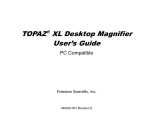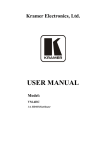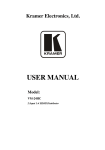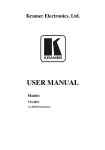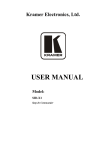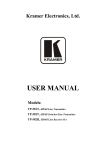Download USER MANUAL
Transcript
K R A ME R E LE CT R O N IC S L TD . USER MANUAL MODEL: VM-24HC 2 Input 1:4 HDMI Distributor P/N: 2900-000717 Rev 3 Contents 1 Introduction 1 2 2.1 2.2 2.3 3 3.1 Getting Started Achieving the Best Performance Safety Instructions Recycling Kramer Products Overview Defining the VM-24HC 2 Input 1:4 HDMI Distributor 2 2 3 3 4 5 4 Connecting the VM-24HC 6 5 5.1 5.2 5.3 Using the VM-24HC 2 Input 1:4 HDMI Distributor Selecting an Active Input Connecting a PC/Controller via RS-232 Acquiring the EDID 8 8 8 9 6 Technical Specifications 11 7 Default Communication Parameters 12 8 Default EDID 13 9 9.1 9.2 Protocol 2000 Syntax Instruction Codes 15 15 16 Figures Figure 1: VM-24HC 2 Input 1:4 HDMI Distributor Figure 2: Connecting the VM-24HC 2 Input 1:4 HDMI Distributor VM-24HC – Contents 5 7 i 1 Introduction Welcome to Kramer Electronics! Since 1981, Kramer Electronics has been providing a world of unique, creative, and affordable solutions to the vast range of problems that confront video, audio, presentation, and broadcasting professionals on a daily basis. In recent years, we have redesigned and upgraded most of our line, making the best even better! Our 1,000-plus different models now appear in 11 groups that are clearly defined by function: GROUP 1: Distribution Amplifiers; GROUP 2: Switchers and Routers; GROUP 3: Control Systems; GROUP 4: Format/Standards Converters; GROUP 5: Range Extenders and Repeaters; GROUP 6: Specialty AV Products; GROUP 7: Scan Converters and Scalers; GROUP 8: Cables and Connectors; GROUP 9: Room Connectivity; GROUP 10: Accessories and Rack Adapters and GROUP 11: Sierra Products. Congratulations on purchasing your Kramer VM-24HC 2 Input 1:4 HDMI Distributor, which is ideal for the following typical applications: Home theater, presentation and multimedia applications Rental and staging VM-24HC - Introduction 1 2 Getting Started We recommend that you: Unpack the equipment carefully and save the original box and packaging materials for possible future shipment Review the contents of this user manual i 2.1 Go to http://www.kramerelectronics.com/support/product_downloads.asp to check for up-to-date user manuals, application programs, and to check if firmware upgrades are available (where appropriate). Achieving the Best Performance To achieve the best performance: Use only good quality connection cables (we recommend Kramer highperformance, high-resolution cables) to avoid interference, deterioration in signal quality due to poor matching, and elevated noise levels (often associated with low quality cables) Do not secure the cables in tight bundles or roll the slack into tight coils Avoid interference from neighboring electrical appliances that may adversely influence signal quality Position your Kramer VM-24HC away from moisture, excessive sunlight and dust ! 2 This equipment is to be used only inside a building. It may only be connected to other equipment that is installed inside a building. VM-24HC - Getting Started 2.2 Safety Instructions ! 2.3 Caution: There are no operator serviceable parts inside the unit Warning: Use only the Kramer Electronics input power wall adapter that is provided with the unit Warning: Disconnect the power and unplug the unit from the wall before installing Recycling Kramer Products The Waste Electrical and Electronic Equipment (WEEE) Directive 2002/96/EC aims to reduce the amount of WEEE sent for disposal to landfill or incineration by requiring it to be collected and recycled. To comply with the WEEE Directive, Kramer Electronics has made arrangements with the European Advanced Recycling Network (EARN) and will cover any costs of treatment, recycling and recovery of waste Kramer Electronics branded equipment on arrival at the EARN facility. For details of Kramer’s recycling arrangements in your particular country go to our recycling pages at http://www.kramerelectronics.com/support/recycling/. VM-24HC - Getting Started 3 3 Overview The VM−24HC is a high−performance switcher and distribution amplifier for HDMI signals. The unit accepts one of two HDMI inputs and distributes the selected signal to four HDMI outputs simultaneously. The VM-24HC features: A maximum data rate of 6.75Gbps (2.25Gbps per graphics channel) HDTV compatibility HDCP compliance I-EDIDPro™ Kramer Intelligent EDID Processing™, an intelligent EDID handling & processing algorithm ensures Plug and Play operation for HDMI systems EDID handling that acquires the EDID from one output, from all connected outputs (auto−mix) or uses a default EDID Kramer Equalization & re-Klocking™ Technology that rebuilds the digital signal to travel longer distances HDMI support for Deep Color, x.v.Color™, up to 7.1 Uncompressed Audio Channels 3D Pass-Through Flexible control options via front panel, IR remote & RS−232 Compact desktop size where two units can be rack mounted side−by−side in a 1U rack space with the optional RK−1 adapter 4 VM-24HC - Overview 3.1 Defining the VM-24HC 2 Input 1:4 HDMI Distributor This section defines the VM-24HC. Figure 1: VM-24HC 2 Input 1:4 HDMI Distributor # Feature 1 IR Receiver IR signal sensor for the IR remote control 2 IR LED Lights yellow when the device receives an IR signal 3 POWER LED Lights green when the device receives power 4 EDID READ Button Press to acquire the EDID following selecting the EDID source. Press again to indicate the EDID status 5 EDID SELECT Button Press to select the EDID source (single output, AutoMix or default) 6 OUTPUT LEDs (1 to 4) Lights green when an output is connected and active. LED flashes to indicate the source of the EDID acquired (see Section 5.3) or when connecting a non-HDCP display while providing HDCP content to the VM-24HC 7 INPUT SELECTOR Button Press to select Input 1 or 2 (see Section 5.1) 8 IN 1 LED Lights green when Input 1 is selected IN 2 LED Lights green when Input 2 is selected 9 INPUT 1 and INPUT 2 HDMI Connectors Connect to the HDMI sources 1 and 2 10 OUTPUT 1 to OUTPUT 4 HDMI Connectors Connect to the HDMI acceptors 1 to 4 11 RS-232 9-pin D-sub Port Connects to a PC/remote controller (see Section 5.1) 12 5V DC Power Connector Connects to the power adapter, center pin positive VM-24HC - Overview Function 5 4 Connecting the VM-24HC i Always switch off the power to each device before connecting it to your VM-24HC. After connecting your VM-24HC, connect its power and then switch on the power to each device. To connect the VM-24HC as illustrated in the example in Figure 2: 1. Connect the two HDMI sources, for example, a DVD player and a set top box to the INPUT 1 and INPUT 2 connectors, respectively. 2. Connect the HDMI OUTPUT connectors to up to 4 HDMI acceptors. In this example, connect: Not all outputs need be connected. OUTPUT 1 to display device 1 (for example, an LCD TV) OUTPUT 2 to display device 2 (for example, an LCD TV) OUTPUT 3 to display device 3 (for example, an LCD TV) OUTPUT 4 to display device 4 (for example, a plasma display) 3. If required, connect a PC and/or controller to the RS-232 port (see Section 5.1). 4. Connect the power adapter to the device and to the mains electricity (not shown in Figure 2). 5. If required, acquire the EDID (see Section 5.3). 6 VM-24HC - Connecting the VM-24HC Figure 2: Connecting the VM-24HC 2 Input 1:4 HDMI Distributor VM-24HC - Connecting the VM-24HC 7 5 Using the VM-24HC 2 Input 1:4 HDMI Distributor The VM-24HC always displays the video output on all of the four outputs at the same time (once they are ready to display the output) upon power up and when switching an input (from IN 1 to IN 2 and vice versa). This section describes: 5.1 Selecting an Active Input (see Section 5.1) Connecting a PC/Controller via RS-232 (see Section 5.2) Acquiring the EDID (see Section 5.3) Selecting an Active Input but we need a note somewhere in there stating the video output will be displayed simultaneously upon power up or introduction of new video once all output ports are ready To select an active input: 5.2 Press the INPUT SELECTOR button to toggle between inputs 1 and 2 Connecting a PC/Controller via RS-232 You can connect a PC or serial controller to the VM-24HC using the RS-232 connection. Note that a null-modem adapter/connection is not required. To connect to the VM-24HC via RS-232: Connect the RS-232 9-pin D-sub rear panel port on the VM-24HC unit via a 9-wire straight cable (only pin 2 to pin 2, pin 3 to pin 3, and pin 5 to pin 5 need to be connected) to the RS-232 9-pin D-sub port on your PC/controller 8 VM-24HC - Using the VM-24HC 2 Input 1:4 HDMI Distributor 5.3 Acquiring the EDID Initially the VM-24HC operates with the factory default EDID stored in the nonvolatile memory. The source reads the EDID from the device when the device is plugged in or powered on. This is usually done only once when the unit is being set up in an installation. Once acquired, the EDID is saved in non-volatile memory and further acquisition is not necessary. The VM-24HC reads the EDID, which is stored in the non-volatile memory. The EDID can be acquired from: One output The default EDID Up to four connected outputs using the Auto-mix Mode The EDID acquired is a weighted average of all the connected outputs. For example, if several displays with different resolutions are connected to the outputs, the acquired EDID supports all the resolutions, as well as other parameters included in the EDID. Repeatedly pressing the EDID SELECT button cycles through the EDID sources in the following order: If you attempt to acquire the EDID from an output that is not connected the default EDID is acquired. Output 1 (Output 1 LED lights) Output 2 (Output 2 LED lights) Output 3 (Output 3 LED lights) Output 4 (Output 4 LED lights) Default EDID (all LEDs light) Auto-Mix EDID (the LEDs flash in a running sequence) To store the selected EDID, press EDID READ as described in the following example. To cancel the EDID modification wait for a few seconds without touching any button. To select the EDID from Output 3: 1. Press the EDID SELECT button repeatedly until OUTPUT 3 LED lights. VM-24HC - Using the VM-24HC 2 Input 1:4 HDMI Distributor 9 2. Press the EDID READ button. When the LED stops flashing the EDID from Output 3 is stored at the input. Pressing the EDID SELECT button briefly once causes the relevant LEDs to indicate which EDID is stored at the input as follows: OUTPUT 1 LED flashes—the EDID from OUTPUT 1 was the last acquired OUTPUT 2 LED flashes—the EDID from OUTPUT 2 was the last acquired, and so on All OUTPUT LEDs light—the default EDID was the last acquired All OUTPUT LEDs flash sequentially—the Auto-Mix EDID was the last acquired 10 VM-24HC - Using the VM-24HC 2 Input 1:4 HDMI Distributor 6 Technical Specifications INPUTS: 2 HDMI connectors OUTPUTS: 4 HDMI connectors BANDWIDTH: Supports up to 2.25Gbps bandwidth per graphic channel COMPLIANCE WITH HDMI STANDARD: Supports HDMI and HDCP CONTROLS: EDID SELECT, EDID READ, IN 1, IN 2 buttons, RS-232, IR INDICATOR LEDs: POWER, IR, OUTPUT POWER CONSUMPTION: 5V DC, 1.1A OPERATING TEMPERATURE: 0° to +40°C (32° to 104°F) STORAGE TEMPERATURE: -40° to +70°C (-40° to 158°F) HUMIDITY: 10% to 90%, RHL non-condensing DIMENSIONS: 21.5cm x 16.3cm x 4.4cm (8.5” x 6.4” x 1.7”) W, D, H WEIGHT: 0.6kg (1.3lbs) approx. ACCESSORIES: Power supply OPTIONS: RK-1 19” rack adapter Specifications are subject to change without notice at http://www.kramerelectronics.com VM-24HC - Technical Specifications 11 7 Default Communication Parameters EDID EDID data is passed between Output 1 and Input 1 RS-232 Protocol 2000 12 Baud Rate 9600 Data Bits 8 Stop Bits 1 Parity None Command Format HEX Example (Output 1 to Input 1) 0x01, 0x81, 0x81, 0x81 VM-24HC - Default Communication Parameters 8 Default EDID Monitor Model name............... VM24HC Manufacturer............. KRM Plug and Play ID......... KRM0023 Serial number............ 505-707455010 Manufacture date......... 2009, ISO week 10 Filter driver............ None ------------------------EDID revision............ 1.3 Input signal type........ Digital Color bit depth.......... Undefined Display type............. RGB color Screen size.............. 520 x 320 mm (24.0 in) Power management......... Standby, Suspend, Active off/sleep Extension blocs.......... 1 (CEA-EXT) ------------------------DDC/CI................... n/a Color characteristics Default color space...... Non-sRGB Display gamma............ 2.20 Red chromaticity......... Rx 0.674 - Ry 0.319 Green chromaticity....... Gx 0.188 - Gy 0.706 Blue chromaticity........ Bx 0.148 - By 0.064 White point (default).... Wx 0.313 - Wy 0.329 Additional descriptors... None Timing characteristics Horizontal scan range.... 30-83kHz Vertical scan range...... 56-76Hz Video bandwidth.......... 170MHz CVT standard............. Not supported GTF standard............. Not supported Additional descriptors... None Preferred timing......... Yes Native/preferred timing.. 1280x720p at 60Hz (16:10) Modeline............... "1280x720" 74.250 1280 1390 1430 1650 720 725 730 750 +hsync +vsync Standard timings supported 720 x 400p at 70Hz - IBM VGA 640 x 480p at 60Hz - IBM VGA 640 x 480p at 75Hz - VESA 800 x 600p at 60Hz - VESA 800 x 600p at 75Hz - VESA 1024 x 768p at 60Hz - VESA 1024 x 768p at 75Hz - VESA 1280 x 1024p at 75Hz - VESA 1280 x 1024p at 60Hz - VESA STD 1600 x 1200p at 60Hz - VESA STD 1152 x 864p at 75Hz - VESA STD EIA/CEA-861 Information Revision number.......... 3 IT underscan............. Supported Basic audio.............. Supported YCbCr 4:4:4.............. Supported YCbCr 4:2:2.............. Supported Native formats........... 1 Detailed timing #1....... 1920x1080p at 60Hz (16:10) Modeline............... "1920x1080" 148.500 1920 2008 2052 2200 1080 1084 1089 1125 +hsync +vsync Detailed timing #2....... 1920x1080i at 60Hz (16:10) Modeline............... "1920x1080" 74.250 1920 2008 2052 2200 1080 1084 1094 1124 interlace +hsync +vsync Detailed timing #3....... 1280x720p at 60Hz (16:10) Modeline............... "1280x720" 74.250 1280 1390 1430 1650 720 725 730 750 +hsync +vsync Detailed timing #4....... 720x480p at 60Hz (16:10) Modeline............... "720x480" 27.000 720 736 798 858 480 489 495 525 -hsync -vsync VM-24HC - Default EDID 13 CE video identifiers (VICs) - timing/formats supported 1920 x 1080p at 60Hz - HDTV (16:9, 1:1) 1920 x 1080i at 60Hz - HDTV (16:9, 1:1) 1280 x 720p at 60Hz - HDTV (16:9, 1:1) [Native] 720 x 480p at 60Hz - EDTV (16:9, 32:27) 720 x 480p at 60Hz - EDTV (4:3, 8:9) 720 x 480i at 60Hz - Doublescan (16:9, 32:27) 720 x 576i at 50Hz - Doublescan (16:9, 64:45) 640 x 480p at 60Hz - Default (4:3, 1:1) NB: NTSC refresh rate = (Hz*1000)/1001 CE audio data (formats supported) LPCM 2-channel, 16/20/24 bit depths at 32/44/48 kHz CE vendor specific data (VSDB) IEEE registration number. 0x000C03 CEC physical address..... 1.0.0.0 Maximum TMDS clock....... 165MHz CE speaker allocation data Channel configuration.... 2.0 Front left/right......... Yes Front LFE................ No Front center............. No Rear left/right.......... No Rear center.............. No Front left/right center.. No Rear left/right center... No Rear LFE................. No Report information Date generated........... 08-Dec-11 Software revision........ 2.60.0.972 Data source.............. File Operating system......... 5.1.2600.2.Service Pack 3 Raw data 00,FF,FF,FF,FF,FF,FF,00,2E,4D,23,00,01,01,01,01,0A,13,01,03,80,34,20,78,EA,B3,25,AC,51,30,B4,26, 10,50,54,A5,4B,00,81,80,A9,40,71,4F,01,01,01,01,01,01,01,01,01,01,01,1D,00,72,51,D0,1E,20,6E,28, 55,00,07,44,21,00,00,1E,00,00,00,FF,00,35,30,35,2D,37,30,37,34,35,35,30,31,30,00,00,00,FC,00,56, 4D,32,34,48,43,20,20,20,20,20,20,0A,00,00,00,FD,00,38,4C,1E,53,11,00,0A,20,20,20,20,20,20,01,B7, 02,03,1B,F1,48,10,05,84,03,02,07,16,01,23,09,07,07,65,03,0C,00,10,00,83,01,00,00,02,3A,80,18,71, 38,2D,40,58,2C,45,00,07,44,21,00,00,1E,01,1D,80,18,71,1C,16,20,58,2C,25,00,07,44,21,00,00,9E,01, 1D,00,72,51,D0,1E,20,6E,28,55,00,07,44,21,00,00,1E,8C,0A,D0,8A,20,E0,2D,10,10,3E,96,00,07,44,21, 00,00,18,00,00,00,00,00,00,00,00,00,00,00,00,00,00,00,00,00,00,00,00,00,00,00,00,00,00,00,00,47 14 VM-24HC - Default EDID 9 Protocol 2000 This RS-232/RS-485 communication protocol uses four bytes of information as defined below. For RS-232, a null-modem connection between the machine and controller is used. The default data rate is 9600 baud, with no parity, 8 data bits and 1 stop bit. Note: Compatibility with Kramer’s Protocol 2000 does not mean that a machine uses all of the commands below. Each machine uses a sub-set of Protocol 2000, according to its needs. 9.1 Syntax MSB LSB 1st Byte 0 7 DESTINATION D 6 INSTRUCTION N2 2 N5 5 N4 4 N3 3 2nd Byte 1 7 I6 6 I5 5 I4 4 INPUT I3 3 3rd Byte 1 7 O6 6 O5 5 O4 4 OUTPUT O3 3 4th Byte 1 7 OVR 6 X 5 M4 4 M3 3 N1 1 N0 0 I2 2 I1 1 I0 0 O2 2 O1 1 O0 0 MACHINE NUMBER M2 M1 2 1 M0 0 Bit 7 – Defined as 0 D – DESTINATION: 0 – Sends information to the switchers (from the PC) 1 – Sends information to the PC (from the switcher) N5…N0 – INSTRUCTION The 6-bit INSTRUCTION defines the function performed by the switcher(s). If a function is performed using the machine’s keyboard, these bits are set with the INSTRUCTION NO. performed. The instruction codes are defined according to the table below (INSTRUCTION NO. is the value set in N5…N0). 1st Byte: Bit 7 – Defined as 1 I6…I0 – INPUT When switching (i.e. instruction codes 1 and 2), the 7-bit INPUT is set as the input number to be switched. If switching is done using the machine’s front panel, these bits are set with the INPUT NUMBER switched. For other operations, these bits are defined according to the table. 2nd Byte: Bit 7 – Defined as 1 O6…O0 – OUTPUT When switching (i.e. instruction codes 1 and 2), the 7-bit OUTPUT is set as the output number to be switched. If switching is done using the machine’s front panel, these bits are set with the OUTPUT NUMBER switched. For other operations, these bits are defined according to the table. 3rd Byte: Bit 7 – Defined as 1 Bit 5 – Don’t care OVR – Machine number override M4…M0 – MACHINE NUMBER This byte is used to address machines in a system by their machine numbers. When several machines are controlled from a single serial port, they are usually configured together and each machine has an individual machine number. If the OVR bit is set, then all machine numbers accept (implement) the command and the addressed machine replies. When a single machine is controlled over the serial port, always set M4…M0 to 1, and make sure that the machine itself is configured as MACHINE NUMBER = 1. 4th Byte: VM-24HC - Protocol 2000 15 9.2 Instruction Codes All the values in the table are decimal, unless otherwise stated Instruction Codes for Protocol 2000 Instruction Definition for Specific Instruction # Description Input Output 1 SWITCH VIDEO REQUEST WHETHER PANEL IS LOCKED IDENTIFY MACHINE Set equal to video output that is switched (0 = to all the outputs) 0 2, 15 31 Set equal to video input that is switched (0 = disconnect) 0 1 – Video machine name 2 – Audio machine name 3 – Video software version 4 – Audio software version 5 – RS-422 controller name 6 – RS-422 controller version 7 – Remote control name 8 – Remote software version 9 – Protocol 2000 revision 10 – Control data machine name 11 – Control data software version 1 – Number of inputs 2 – Number of outputs 3 – Number of setups For names: 0 – Request first 4 digits 1 – Request first suffix 2 – Request second suffix 3 – Request third suffix 10 – Request first prefix 11 – Request second prefix 12 – Request third prefix 13 61 62 DEFINE MACHINE Notes 16 For versions: 0 – main board or the number of external board 1 – For video 2 – For audio 3 – For SDI 4 – For remote panel 5 – For RS-422 controller 6 – For control data 14 NOTES on the above table: NOTE 2 – These are bi-directional definitions. If the switcher receives the code, it performs the instruction. If the instruction is performed (due to a keystroke operation on the front panel), then these codes are sent. For example, if the PC sends HEX code: 01 85 88 83 then the switcher (machine 3) switches input 5 to output 8. If the user switches input 1 to output 7 using the front panel buttons, the switcher sends HEX code: 41 81 87 83 to the PC. When the PC sends one of the commands in this group to the switcher, if the instruction is valid, the switcher replies by sending the same four bytes to the PC that it received (except for the first byte, where the DESTINATION bit is set high). NOTE 13 – This is a request to identify the switcher/s in the system. If the OUTPUT is set as 0, and the INPUT is set as 1, 2, 5 or 7, the machine sends its name. The reply is the decimal value of the INPUT and OUTPUT. For example, for a 2216, the reply to the request to send the audio machine name is HEX code: 7D 96 90 81 (i.e. 128dec+ 22dec for 2nd byte, and 128dec+ 16dec for 3rd byte). If the request for identification is sent with the INPUT set as 3 or 4, the appropriate machine sends its software version number. Again, the reply would be the decimal value of the INPUT and OUTPUT - the INPUT representing the number in front of the decimal point, and the OUTPUT representing the number after it. For example, for version 3.5, the reply to the request to send the version number would be HEX code: 7D 83 85 81 (i.e. 128dec+ 3dec for 2nd byte, 128dec+ 5dec for 3rd byte). If the OUTPUT is set as 1, then the ASCII coding of the lettering following the machine’s name is sent. For example, for the VS-7588YC, the reply to the request to send the first suffix would be HEX code: 7D D9 C3 81 (i.e. 128dec+ ASCII for “Y”; 128dec+ ASCII for “C”). NOTE 14 – The number of inputs and outputs refers to the specific machine being addressed, not to the system. For example, if six 16x16 matrices are configured to make a 48x32 system (48 inputs, 32 outputs), the reply to the HEX code: 3E 82 81 82 (i.e. request the number of outputs) would be HEX code: 7E 82 90 82 (i.e. 16 outputs). NOTE 15 – When the OVR bit (4th byte) is set, then the video commands have universal meaning. For example, instruction 1 (SWITCH VIDEO) causes all units (including audio, data, etc.) to switch. Similarly, if a machine is in FOLLOW mode, it performs any video instruction. NOTE 16 – The reply to the REQUEST WHETHER PANEL IS LOCKED is the same as in NOTE 4 above, except that OUTPUT is assigned with the value 0 if the panel is unlocked, or 1 if it is locked. 16 VM-24HC - Protocol 2000 For the latest information on our products and a list of Kramer distributors, visit our Web site where updates to this user manual may be found. We welcome your questions, comments, and feedback. Web site: www.kramerelectronics.com E-mail: [email protected] ! P/N: SAFETY WARNING Disconnect the unit from the power supply before opening and servicing 2900- 000717 Rev: 3
























